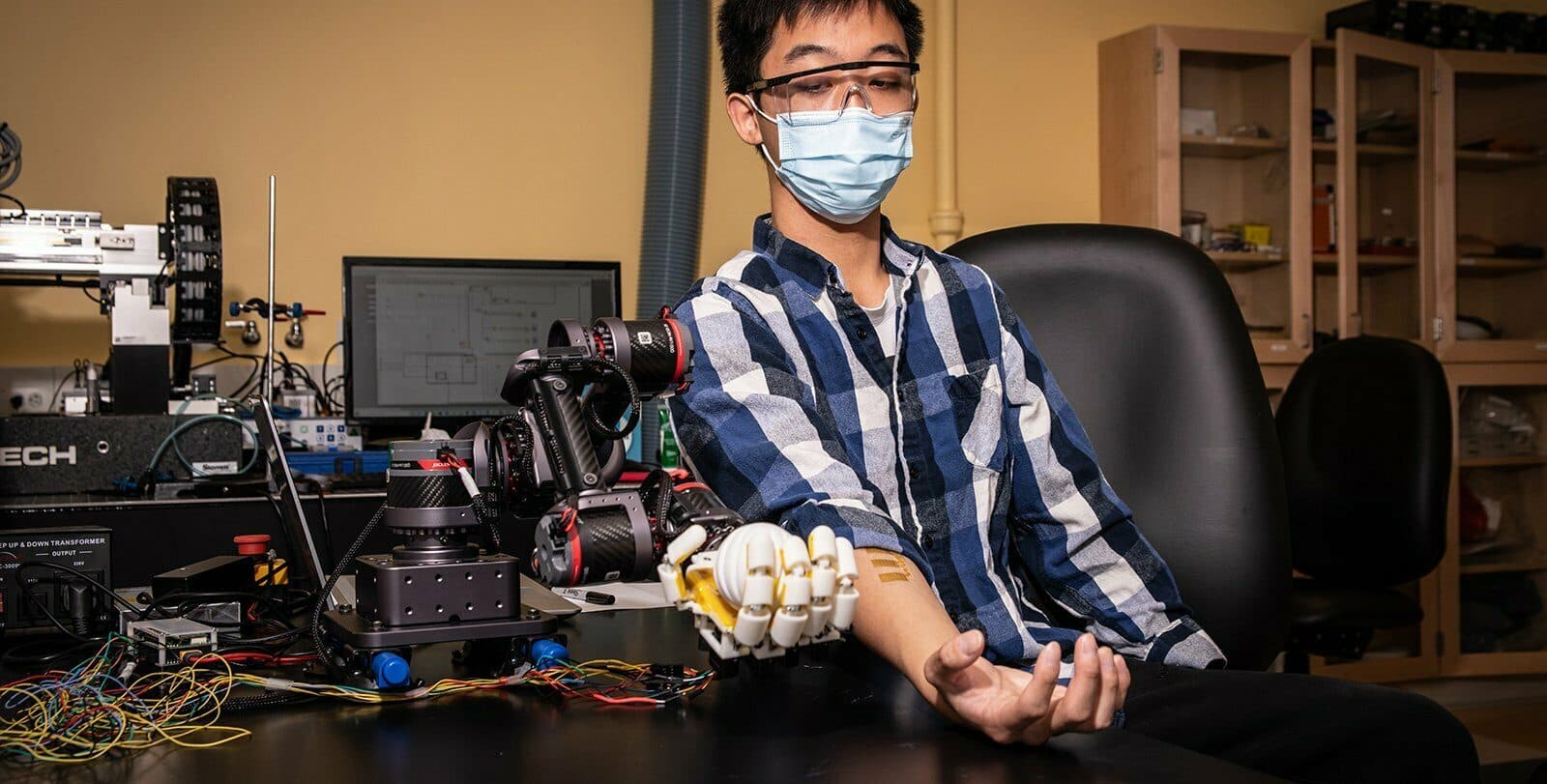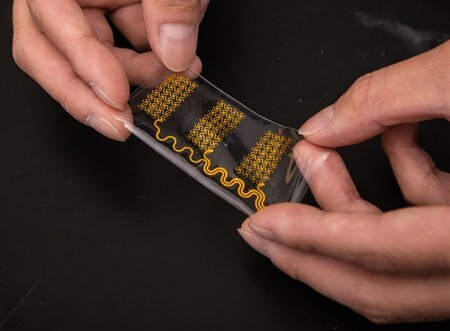Quantum Sound and Robotic Arms
by Alan S. Brown
Research highlights from Kavli Nanoscience Institutes

The Author
As summer heats up, so does quantum research at Kavli Institutes. At Delft University of Technology, a team has found a simple way to produce entangled photons that can zip along conventional telecom optical fibers. This is a big step towards real-world quantum networks. Also at Delft, researchers created a chip that enables them to explore phonons, quantum units of vibration large enough to interact with larger objects like quantum dots. Meanwhile, a researcher at Caltech has developed a robotic arm that enables humans to sense things like viruses, explosives, and toxic materials. We also take a look at two videos from Caltech that tap Kavli experts to explain the possibilities of quantum materials and why alternate technologies will have a hard time replacing lithium-ion batteries.
Another step towards quantum networks
Quantum networks that reach everywhere could be extraordinarily expensive—unless they can use existing telecom fiber. Now researchers have found a way to do that, led by Ronald Hanson and his Ph.D. student, Arian Stolk, of the Kavli Institute of Nanoscience at Delft University of Technology. Quantum networks based on photons face several hurdles. The first is that leading quantum platforms emit visible light and those photons dissipate while traveling only a few kilometers over a fiber network. To go further would take a quantum repeater, a device that takes an entangled photon and entangles it with another photon that it then sends on its way. Still, that’s a lot of repeaters, and the quantum chips used in different nodes may not always be compatible. The solution is based on a technique called quantum frequency conversion, which uses a strong pump laser to interact with single photons inside a vacancy created in a diamond crystal. The frequency of the laser controls the frequency of the photon, enabling the creation of photons optimized to race down much longer lengths of conventional telecom fibers. The converted photons are highly indistinguishable from one another, a key requirement for scientifically and technologically useful quantum entanglement. Next up: building a 20-kilometer-long fiber network to evaluate the approach.
Quantum sound?
Many recent quantum achievements are built on the ability to manipulate non-classical properties of light, for example entangling photons. Simon Groeblacher, a member of the Kavli Institute of Nanoscience at Delft University of Technology, is pioneering ways to achieve similar non-classical states in quantum acoustics, involving phonons—the quantum unit of vibration—rather than photons of light. The result could lead to new types of devices for quantum information processing and other advanced quantum acoustics experiments. Compared to photons, phonons have extremely low energy and slow propagation speeds and have been shown to efficiently couple with other solid-state quantum systems (such as superconducting qubits and quantum dots), making them in some ways more suited for on-chip quantum operations. Groeblacher’s latest achievement is a way to build phononic waveguides in silicon thin films, the vibrational equivalent of waveguides used to direct light, and transmit phonons over several centimeters within a chip. The result is a kit that will enable other researchers to pursue phonon-related experiments.
Cyborg arm enhances human touch

Wei Gao, a member of the Kavli Nanoscience Institute at Caltech, has developed a robotic arm, M-Bot, that works like an extension of a human arm, including sensation. Using machine learning to create an interface between the human and robot, Gao’s arm moves based on muscle contractions humans make to move their arm. M-Bot, like other haptic arms, also sends feedback (pressure) back to the user. What makes this arm different is that the robotic arm is coated with sensors that transmit information directly to the operator’s skin. This tells operators if an object is hot or heavy, and also—and this goes well beyond human capabilities—whether it is toxic or contains a certain type of virus. Gao prints the sensors on a soft hydrogel skin covered with nanoparticle wires using a device similar to an inkjet printer. Though it is still in the proof-of-concept stage, operators could one day use it to determine how much pesticide they applied to a field or whether a suspicious backpack in an airport contains traces of explosives.
Could quantum materials revolutionize semiconductors?
Caltech recently interviewed Nai-Chang Yeh about the future of quantum materials and their potential application. Yeh, a former director (and current member) of Caltech’s Kavli Nanoscience Institute, develops new tools to investigate quantum materials, so she has a deep understanding of everything from graphene, superconductors, and topological materials to low-dimensional and engineered quantum materials. One point she made involved the use of quantum materials to improve conventional semiconductors. As semiconductor features shrink to a handful of nanometers, problems arise with quantum conductance, quantum capacitance, quantum charge fluctuations, and heat dissipation. Engineers could potentially use quantum materials to create additional channels to conduct electricity and heat as well as prevent atoms from migrating in nanostructures, Yeh explained. She also discussed the potential application of higher-temperature superconductors and other quantum materials, such as quantum dots and cooled atoms, to quantum computers. The video contains lots of fascinating nuggets, including Yeh’s take on her mentor (and Kavli Prize Laureate), Millie Dresselhaus.
Why lithium-ion batteries remain the standard
Anyone whose smartphone died in the middle of the afternoon must wonder why we cannot make better batteries. To find out, Caltech interviewed two Kavli Nanoscience Institute experts, director Julia Greer and member Kimberly See. Li-ion batteries have imposing advantages, they said. They store large quantities of energy, as 30 years of research have improved their performance dramatically. Yet Li-ion batteries require problematic materials like nickel and cobalt. Attempts to use metal electrodes to boost power and recharging speed creates growths, called dendrites, which break the electrodes apart. Greer’s approach focuses on solid electrolytes, which could mechanically “squeeze” metal electrodes to suppress dendrite formation. See, on the other hand, is investigating entire alternate systems—anodes, cathodes, and electrolytes—based on calcium, magnesium, or zinc that have the potential to match or exceed lithium’s energy storage capacity while also being more environmentally and economically friendly.